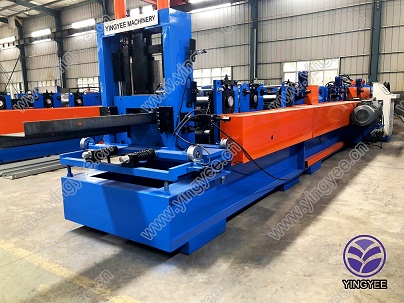
The Advantages of Square and Round Downspout Roll Forming Machines
In the realm of metal fabrication and construction, the importance of efficient and innovative machinery cannot be overstated. One such advancement is the square and round downspout roll forming machine, a specialized piece of equipment designed to produce downspouts in square and round shapes with precision and efficiency. This technology not only enhances productivity but also improves the overall quality of the final product.
Understanding Downspouts and Their Importance
Downspouts are essential components of any building’s drainage system. They direct rainwater collected from the gutters away from the structure, preventing water damage, erosion, and other structural issues. Traditionally, downspouts were made from various materials such as vinyl, aluminum, or galvanized steel, but the introduction of roll forming techniques has revolutionized the manufacturing process.
The Roll Forming Process
Roll forming is a continuous bending operation in which a long strip of sheet metal passes through consecutive pairs of rolls that progressively shape the metal into a desired profile. This process is highly efficient for producing long lengths of uniform cross-section, making it ideal for downspouts, which often need to be produced in bulk.
The square and round downspout roll forming machines are designed to accommodate the specific needs of fabricators and contractors. They can produce different sizes and styles of downspouts with minimal adjustments, allowing for versatility in construction projects.
Advantages of Using Roll Forming Machines

1. Efficiency and Speed One of the most significant advantages of using a square and round downspout roll forming machine is the speed at which it operates. These machines can produce a large number of downspouts in a short amount of time, making them ideal for high-volume projects.
2. Precision and Consistency Roll forming machines offer a high level of precision, ensuring that each downspout is uniform in dimension and shape. This consistency reduces the chances of errors during installation, leading to better overall project outcomes.
3. Cost-Effectiveness By streamlining the production process, businesses can reduce labor costs and material wastage. Additionally, the efficiency of roll forming can lead to savings on overall production time, translating into lower costs for end customers.
4. Material Versatility Square and round downspout roll forming machines can typically handle various materials, including galvanized steel, stainless steel, and aluminum. This versatility allows manufacturers to cater to diverse client needs, offering different material options based on budget and requirements.
5. Customization Advanced roll forming machines can be easily adjusted to produce downspouts of varying sizes and shapes. This ability to customize production means fabricators can meet specific client requests without significant downtime or reconfiguration.
6. Enhanced Durability The roll forming process often results in stronger products compared to traditional methods. The continuous nature of the forming process typically leads to fewer weak points, increasing the durability and lifespan of the downspouts produced.
Conclusion
The square and round downspout roll forming machine represents an incredible leap forward in the manufacturing of essential building components. Its efficiency, precision, and adaptability make it a critical tool for fabricators looking to optimize their production processes. As the construction industry continues to evolve, investment in such advanced machinery will undoubtedly pay off, providing companies with a competitive edge while also delivering high-quality products to discerning customers. Embracing this technology is not just a choice; it’s a strategic move towards ensuring sustainability, efficiency, and quality in the complex world of construction.